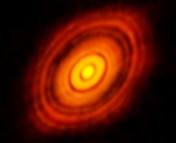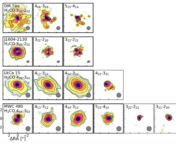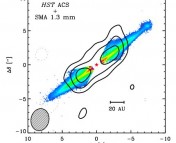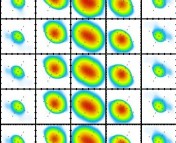Title: Observations of edge-on protoplanetary disks with ALMA I. Results from continuum data
Authors: M. Villenave, F. Menard, W. R. F. Dent et al.
First Author Institution: Univ. Grenoble Alpes, CNRS, IPAG 38000 Grenoble, France
Open access: ArXiV, submitted to A&A
As the famous astronomer and science communicator Carl Sagan said: “The nitrogen in our DNA, the calcium in our teeth, the iron in our blood, the carbon in our apple pies were made in the interiors of collapsing stars. We are made of star stuff” This idea that the ingredients for our apple pies originated from the interiors of stars is pretty impressive, but it begs the question: how did stuff leftover from stars get onto planets like Earth and form humans and life (and pies!)? Astronomers are actively answering that question by studying protoplanetary disks.
Stars form out of clouds of dust and gas, enhanced with the leftovers of dead stars. As the cloud collapses, a disk starts to form around the newly forming star. This disk is called a protoplanetary disk, and is the precursor to planetary systems. They are three main components to a protoplanetary disk: gas, small dust (~micron sized, or 1/50 the width of a human hair), and large dust (~mm sized, or about the size of a pencil tip) (see Figure 1). Each of these components come together to form planets. In particular, the large dust will coagulate to form planet bébés a.k.a. planetesimals. Thus, tracking the large dust and where it is located in a disk over time will shed insight into the beginnings of planet formation.

Edgy Science
In today’s Astrobite, the authors present observations of 12 different protoplanetary disks, looking particularly at wavelengths in which large dust grains emit. They specifically probed edge-on disks, meaning that we are looking at them on their sides. The authors chose to look at edge-on disks in order to measure how high large dust grains extend above the midplane (the middle of the disk). There are two phenomena that describe the large-scale movement of large dust grains. One is ‘vertically settling,’ where grains simply fall down into the midplane, and the other is ‘radially drift,’ where large grains move from large radii towards the central star. These observations are a direct probe of these two phenomena that impact planet formation as well our general understanding of the composition of protoplanetary disks.
These authors used the Atacama Large Millimeter Array (ALMA), a radio telescope situated in the middle of a Chilean desert, to observe these disks with very high resolution and at the low wavelengths at which dust emits. Their observations of 12 edge-on disks are shown in Figure 2.
In these observations, radial drift can be explored by looking at the brightness of an observation along the disk’s major axis (the longest extent of the disk) while vertical settling is best determined by looking at the minor axis (the smaller extent of the disk, perpendicular to the major axis). When looking along the major axis, they found that most of their disks had a singular brightness value for the extent of the disk, with a steep drop-off (see Figure 3 for an example). This indicates that these disks are practically perfectly edge-on and that we are only seeing the surface edge of the disk because in the dusty midplane, the emission farther away from us is blocked (the disk is optically thick).
Along the major axis, the authors find that many of their disks become smaller along the radial direction at longer wavelengths (the longer the observing wavelength, the larger the dust grains that can be observed). This is showing us that the larger particles are drifting inwards radially. However, the observations show a less extreme change in size than previous radial drift calculations have suggested. This, the authors predict, is due to unseen rings and gaps within the disk which can cause pressure traps, slowing down the dust.
Free Fallin’
Tracing how high up the dusty atmosphere is in these disks will tell us about its vertical extent. We expect dust grains to decouple from the gaseous atmosphere once they reach a certain size and fall down to the midplane. To explore the possible effect of this “settling,” the authors created models of disk with high and low mass, and with settling and without settling, and with various inclinations. They ran these models through a radio observation simulator so that they could directly compare the models to the observation.
They found that in their no settling, high mass model (1 x 10-3 Msun) you could actually distinguish between the upper and lower layer of the atmosphere. The lack of evidence for this in their observations, the authors conclude that if any of their models are high mass, then there must be dust settling. They also see that their models tend to be much thicker than the observations, suggesting that the vertical setting is very strong. Based on their observations, they find that typical heights of the large dust will be only a few AU as opposed to ~10 AU that they used in their models, and is common in many other disk models.
By observing protoplanetary disks along their sides, today’s authors directly probed the vertical profile of protoplanetary disks. Their observations support current theories on dust movement in both the radial and vertical directions, providing constraints on the strength of both processes as well. This brings us yet another step closer to understanding how the material in our apple pies get delivered from the outbursting of a star.




